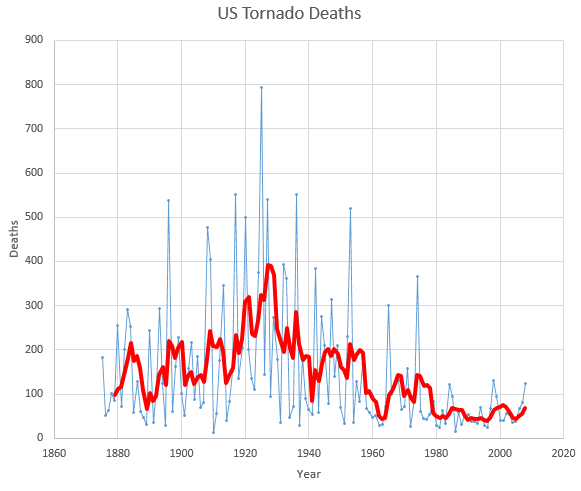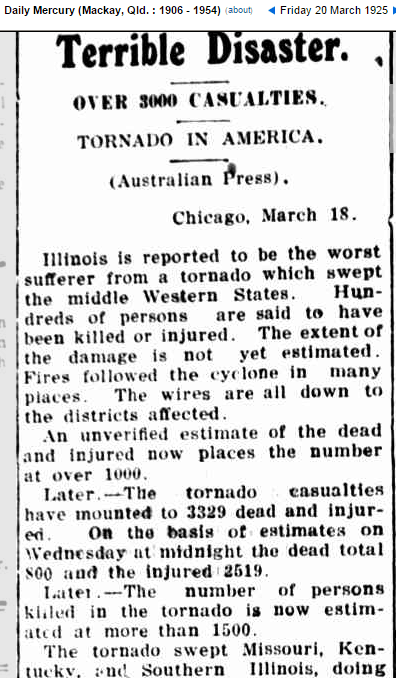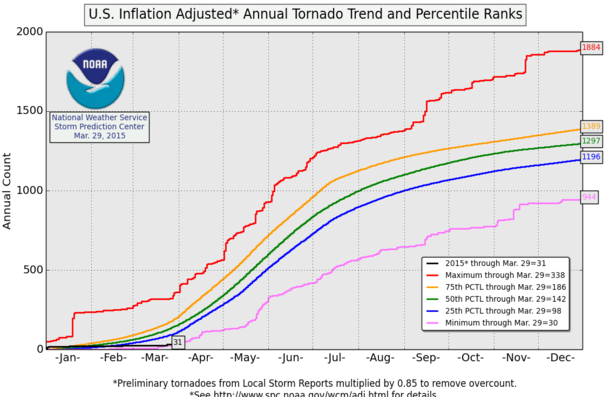US tornado deaths peaked 90 years ago in 1925, the year the Tri-State tornado destroyed many towns in Illinois, Kentucky and Missouri. Since then, tornado deaths have plummeted to record lows.
US Annual Tornado Death Tolls, 1875-present – NOAA Weather Partners
20 Mar 1925 – Terrible Disaster. OVER 3000 CASUALTIES. TORNADO…
2015 is currently on track to be the fourth consecutive year of record low tornado activity in the US.
Inflation Adjusted Tornado Running Totals – Storm Prediction Center WCM Page
Government experts say that weather is getting more extreme in the US, because their job is to promote the White House agenda – regardless of any actual facts.





Forecast polar vortex in the lower stratosphere on April 3.
http://earth.nullschool.net/#2015/04/03/0600Z/wind/isobaric/70hPa/orthographic=-114.65,93.50,344
Reblogged this on Climatism and commented:
Children just aren’t going to know what a Tornado is …
Joe Bastardi is warning that we may see a burst of activity soon. I suspect that will depend on whether or not the polar vortex finally withdraws back to ‘normal’ bounds.
As the earth cools and the jets go loopy I expect to see more ‘extreme weather’ I am sure the Alarmists have also been expecting an up-tick as the earth cools in response to the solar minimum. That is why the Alarm Snake Oil salesmen switched from Gore Bull Warbling to Climate Disruption.
Lets hope Ma Nature holds off for a bit longer.
However the switch can be rather sudden…
Paper after paper began to roll off the scientific presses from 1992 on, and just like the unfolding recognition of plate tectonics which preceded it by a few decades, it was literally riveting for all of us geologists fascinated by the Quaternary. So we get our first trap-speed: climate can switch abruptly from its cold to its warm state in just one year.
Stocker and Marchal (2000) begin their discussion with this:
The End of the Holocene?
Khabibullo Abdusamatov says we just dropped into the next LIA. The last two winters have been rotten, do I really need to experience another 40 years of them?
“The End of the Holocene?”
New World Order propagandists of consensus science would like to call it the Anthropocene, a term that has been batted around for a half-century. This new man-made geological epoch is supposed to be marked by unstoppable global warming and accelerated sea level rise.
Ooops.
https://i0.wp.com/3.bp.blogspot.com/-7BTnRqeqVxo/Usw2ugazZ8I/AAAAAAAA2Vw/Up68eQgj6Aw/s320/mother_nature_denies_global_warming.jpg
Who are you going to place your bets on? Mother Nature of Bill Nye the Science Guy?
I ain’t gunna argue with the big gal. Especially while she’s busy making buffoons out of the buffoons.
😉
even the IPCC admit they know jack sh..
. “There is low confidence in
observed trends in small spatial-scale phenomena such as tornadoes and hail because of data inhomogeneities and inadequacies in monitoring systems”
If I recall correctly, J. Curry has all but abandoned her previous assumptions about such, which she covered in her chapter in UN IPCC AR4.
It is now 32 °F and is supposed to warm to 73° F. Luckily it will be clear and windy…. (Of course the weather forecast for this week has been all over the place and they still do not have it right….)
And since there has been no flow from the gulf north, Nebraska to Canada is very dry. No moisture to evaporate and start the clash.
In Poland, strong blizzards. Is the polar vortex over Europe. Real winter in Scandinavia. All of this can be seen in the stratosphere.
Solar activity falls again.
http://www.cpc.noaa.gov/products/stratosphere/strat_a_f/gif_files/gfs_z70_nh_f00.gif
A little off topic but I was revisiting the Nenana Ice Classic, there’s a comment on WUWT:
However when I go to look for the data, it’s gone. Been lost, or memory holed.
Better make sure we keep records of that.
19:39 April 23 2012
14:41 May 20 2013
15:48 April 25 2014
I got the last one from a news search “The winning time was 3:48 p.m. Alaska Standard Time on April 25” .
Should be a bit early this year if the “warm Alaska” theory holds up, it’s the long term trend that’s more interesting.
I find this and it takes you round and round and round…
That last link takes you back to the same page….
Even if you can find a way through the maze they now have set up most layman can not.
Hubby found the data:
http://sled.alaska.edu/sled/?q=content/what-are-official-breakup-dates-and-times-nenana-ice-classic
(Time to archive it before that copy is disappeared…)
Gail ,
Click on FTP at the top left of the screen (skip registration next page ) for a list of times and a graph
ftp://sidads.colorado.edu/pub/DATASETS/NENANA/
I notice that they have no data available post 2003 , seems rather convenient leaving off 2013 which I think may have been the latest ice out ever .
Interesting. It is not like the data is hard to get.
Here is the post 2003 data from the other data set.
2003 – April 29…….6:22 p.m.
2004 – April 24…….2:16 p.m.
2005 – April 28…..12:01 p.m.
2006 – May 02……..5:29 p.m.
2007 – April 27…….3:47 p.m.
2008 – May 06……10:53 p.m.
2009 – May 1………8:41 p.m.
2010 – April 29 …..9:06 a.m.
2011 – May 4………4:24 p.m.
2012 – April 23 ….7:39 p.m.
2013 – May 20……..2:41 p.m.
>>>>>>>>>>>>>>>>
The early ice-out dates:
1926 – April 26…….4:03 p.m.
1988 – April 27…….9:15 a.m.
1990 – April 24…….5:19 p.m.
1993 – April 23…….1:01 p.m.
1994 – April 29……11:01 p.m.
1995 – April 26…….1:22 p.m.
1997 – April 30…10:28 a.m.
1998 – April 20……4:54 p.m.
2004 – April 24…….2:16 p.m.
2005 – April 28…..12:01 p.m.
2007 – April 27…….3:47 p.m.
2012 – April 23 ….7:39 p.m.
………………..
Most dates are April 30th or later.
Some where I read it takes several years for the warm water from an El Nino to drift north to Alaska.
Here’s the latest from Joe: http://www.weatherbell.com/saturday-summary-march-28-2015
http://www.ospo.noaa.gov/data/sst/contour/global_small.fc.gif
The Tri in the Tri-State Tornado was Missouri, Illinois and Indiana. Kentucky was not hit by that tornado
Naturally, the NWS will pat themselves multiple times on the back, claiming that the falling death rates are a result of their wonderful warning system. Like having such a high percentage of false alarms that most people totally ignore them!
If Congress defunded NASA’s GISS, would anything crucial to our weather/climate or general well-being be negatively impacted?
Our general well-being will go up 1000% after Gavin Schmidt loses his job at GISS.
Now, now. Don’t get your knickers in a twister.
The extreme weather mongers are at it in force. If all you did was listen/watch read the MSM for your weather/climate reports – that is most people – you should clearly believe floods are worse, heat and drought are worse, tornadoes and hurricanes are worse, and the poles are melting (all lies – documentable/documented LIES).
Most people aren’t chemists, geologists, physicists, engineers, or concerned skeptics who follow Climate Audit, WUWT, RealScience, etc., – people who get a completely different perspective and understanding of what’s really going on.
Reblogged this on Globalcooler's Weblog.